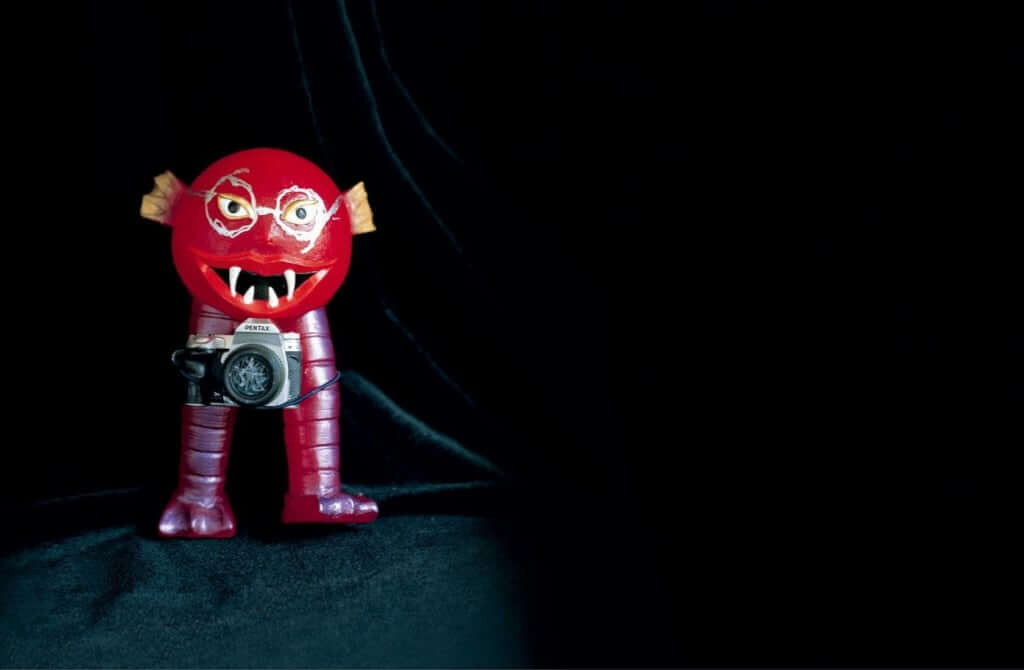The Art World’s Polytropic Genius
Araki: The Photo Devil #02
A curator’s analysis of the unconfined, diverse works that transcend the boundaries of photography. By Ayano Hayashi, Curator.

Araki the Photo Devil Shot exclusively for 'Pen'. Araki created this doll for his artwork, which was showcased at his solo exhibitions, including 'Nega-Eropolis'.
A camera boasting a broken lens hangs from the neck of a red devil doll. This is Araki’s impression of himself. While a master of photography, his creativity pushes the boundaries of what most believe photography is.
A set of still-life photographs entitled ‘Paradise’ depict an erotic doll and a monster toy among other items arranged with a vase of flowers. Over the weekend, Araki shuts himself in and rearranges the groupings ad infinitum—as a child would play with wooden blocks—determining the precise placement of each element. Reminiscent of da Vinci sketching with his left hand, imagining Araki engrossed in his work makes my heart pound with excitement.
‘Paradise’, with its silence and flavor of mortality, is abound with the memento mori symbolism of skull-laden medieval still-life work. Araki embarks on each artistic journey from a concept to create his art—not by observing other work nor solely by taking pictures. His artwork is purely conceptual.
He uses this approach to produce acrylic hand-painted photos. With ardor, he splashes paint onto monochrome images, and the effect is vivid and dynamic. A balance of colors and brushstrokes offer a rhythmic and spirited viewing experience.
Araki feels life is represented by color and death by monochrome, so painting over monochrome prints breathes life into them. His work is unconstrained, shattering any pre-existing idea of what photography is. The images on canvas create a symbiotic relationship between photography and painting. Within his work, his genius lies with a sense of harmony that is true to who he is.
In his limited ten years as an artist, Van Gogh created more than 2,000 paintings. Matisse, in his search for pure colors, traded his paintbrush in for a pair of scissors, preferring cutouts. And, Picasso whose intellectual fodder was gleaned from Mikhail Bakunin’s motto, ‘The urge to destroy is also the creative urge’, single-handedly reshaped the art of his time.
When one stands before Araki’s work, a pedigree of precursive artists come to mind. Then, with an onslaught of ideas one realises that the word ‘photographer’ doesn’t apply to Araki, as it is impossible to interpret his work through the narrow lens of traditional values.
Araki’s powerful work of every genre stimulates not only all five senses, but also moves the viewer’s soul.
The way he plays with light opens the mind, allowing one to hear the reverberating sound of stiletto heels, as a woman sashays down the street. One’s olfactory senses come to life as the fragrance of dried flowers fill the nose, and memories of victuals rise to the taste buds. Each photograph communicates through the sense of touch, lending a sense of warmth to an outstretched hand.
Through Araki’s Sentimental Journey, he endeavours to depict human life through his own body—a visceral communication to anyone who enjoys his work. His thoughts on life and the circumstances of death, which he once came close to through an illness, come out in powerful images. His work speaks to conceptual art, yet not in style, new media or technique. Every photograph offers undeniable life.
In Araki’s world, entwined with light, sound, smell, taste, and warmth, we regain our purest sense of reality. Our heartbeat becomes Araki’s, that tenacious Photo Devil, who tirelessly snaps photos. His art may only be understood by the next generation, much like the work of Van Gogh.
We have no choice but to try to keep up, as he continues to push the boundaries of art and meaning.
Araki: The Photo Devil —
#01: Following the Traces of the Seventy-five Years of the Genius of Photography >
#02: The Art World’s Polytropic Genius
#03: Interview: From Scrapbooks to Volumes >
#04: Araki Himself Explains the Masterpieces that Changed History >
#05: Araki Freely Uses Different Cameras in His Compound-eye Photographic Technique >
#06: His Latest Masterpieces are Shot Based on Five Themes >
TRENDING
-
A Rare Japanese Garden Hidden Within Honen-in Temple in Kyoto
Visible only twice a year, ‘Empty River’, designed by landscape architect Marc Peter Keane, evokes the carbon cycle.

-
Colour Photos of Yakuza Tattoos from the Meiji Period
19th-century photographs have captured the usually hidden tattoos that covered the bodies of the members of Japanese organised crime gangs.

-
Recipe for Ichiraku Ramen from ‘Naruto’ by Danielle Baghernejad
Taken from the popular manga with the character of the same name who loves ramen, this dish is named after the hero's favourite restaurant.

-
Modernology, Kon Wajiro's Science of Everyday Observation
Makeup, beard shape, organisation of cupboards and meeting places: all of these details decipher 1920s Tokyoites.

-
Hitachi Park Offers a Colourful, Floral Breath of Air All Year Round
Only two hours from Tokyo, this park with thousands of flowers is worth visiting several times a year to appreciate all its different types.





